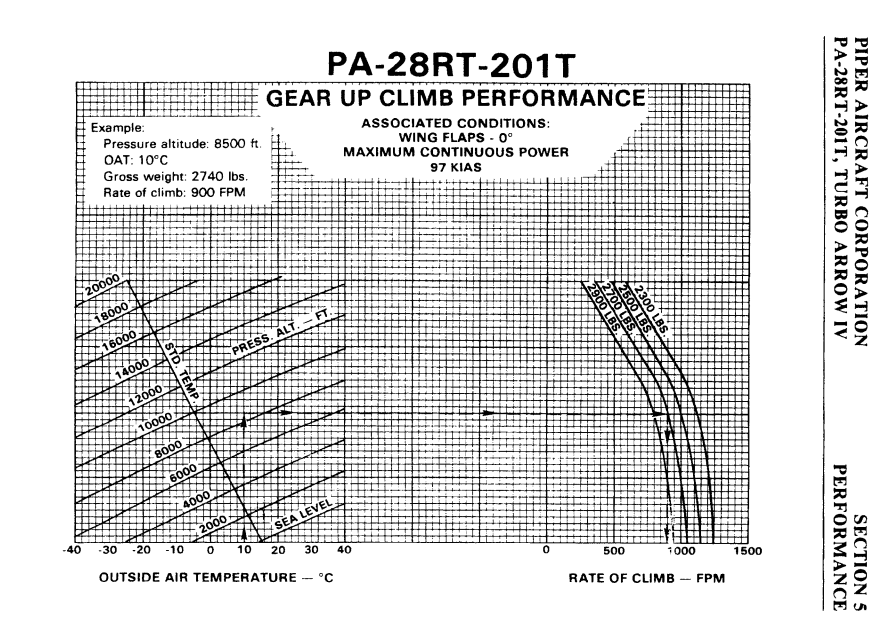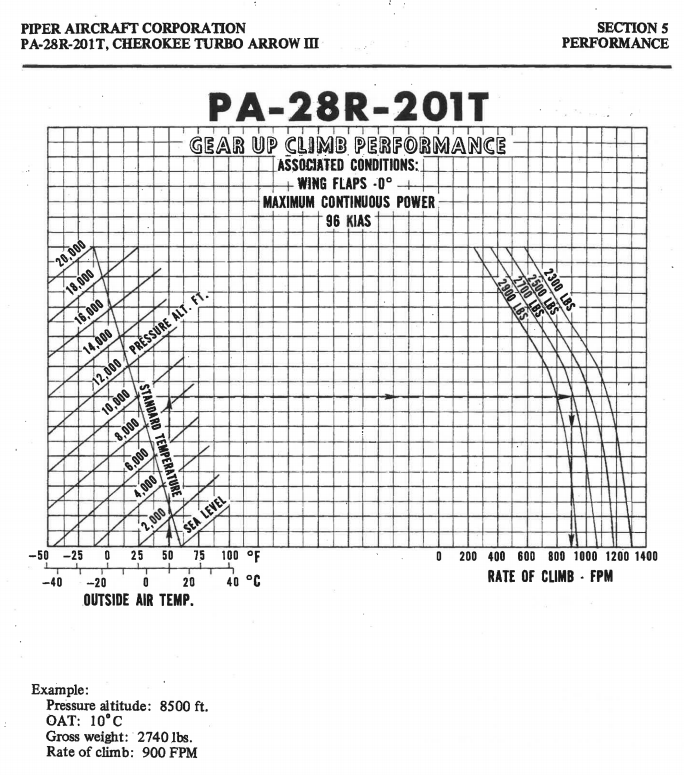Turbo Arrow III and IV performance
Hi Everyone. I have several hundred hours in a normally aspirated arrow III and was thinking of purchasing a turbo arrow III or IV. The turbo model affording some additional useful load, better climb performance and cruise speeds at altitude etc. I’ve absolutely no experience of the T Tail model (although I do think it looks cooler…) but am aware of all the talk of less elevator authority because it's out of the prop wash etc. When I examine the POH performance graphs for both models they suggest the T Tail requires the same or less takeoff roll than the conventional tail, which contradicts all the forum talk I can find for the two models! Just looking at Ground roll figures with 25˚ Flap, 10˚ OAT, Max Gross and nill wind. Sea Level performance for both variants is similar. At 4000 ft its 1400 for the T and 1725 for the III. The 50 ft Barrier graphs suggest similarly increased performance for the T tail. Can this really be ? Anyone out there with real world experience of them both? Before looking at the graphs my hunch was to find a conventional tail model which also has a broader CG range?

Comments
Good questions! I flew a T Tail in a Seminole for five years and 500 hours and loved it. I now have a turbo Arrow III with Merlin Black Magic Upper Deck Controller and Electroair electronic ignition. I've owned 9 TSIO-360's over 30 years and they've been great. Is there anything I can assist with?
Scott Sherer
Wright Brothers Master Pilot, FAA Commercial Pilot
Andy,
Were the gross takeoff assumptions the same? Generally companies will translate more HP into more useful load if they can get away with it from an airframe standpoint and that might be why you are seeing similar performance curves on takeoff.
Another consideration is down low in a cruise climb the turbo is providing modest boost above ambient but must also overcome the lower compression ratio and the backflow from the turbo.
This favors a cruise in the teens where the turbo is really delivering above and beyond what a NA plane can do.
If you look at max performance climbs at equal weights I suspect the difference will be clearer and will further widen at altitude.
Eric Panning
1981 Seneca III
Hillsboro, OR (KHIO)
Thanks for the responses thus far. Assuming I’ve interpreted the takeoff graphs correctly, the numbers quoted were for the turbo arrow III and IV models both at max gross and all other flight parameters equal. I was just surprised to see the IV outperforming the III at increasing pressure altitudes and wondered if that was the real world experience?
Here is the Turbo arrow IV:


And turbo arrow III
They are essentially identical on these charts
Eric Panning
1981 Seneca III
Hillsboro, OR (KHIO)
Thanks Eric. Yes, those two charts are similar. I was refering to the ground roll and takeoff charts which show the IV to outperform the III for increasing pressure altitudes / identical flight conditions. I’ve attached some of them for both aircraft.
And for the Turbo Arrow III
This article is not very positive on the Turbo arrow but it does cover differences + pilot feedback.
https://www.avweb.com/features/piper-pa-28rt-turbo-arrow/
Eric Panning
1981 Seneca III
Hillsboro, OR (KHIO)
I read the article above and I have to dispute most of it. I have not had most of the issues noted in the article. Especially the engine issues. I am at 1550 hrs on original cylinders and flying fine. I do have the merlyn waste gate and gami's and I think that corrects a lot of what we hear so much about.
I have flown the T tail and the handling difference is almost undetectable.
Altitude does improve speed considerably. Below 8000', its basically and NA arrow. Last weekend traveling to Destin,FL I was seeing 130kts true at 7500 (65%) and 142kts true at 9500 (65%). I usually can see 150kts true at 11500.
I do agree that the POH is problematic when it comes to performance charts. And recommended engine settings are very different from the Seneca and the Mooney 231. I basically fly it by the book with some alterations that is easily noticed by performance indications. It is easy to dial it in and sometimes its off a bit from the book.
One thing I can agree with is it is not a short field airplane. It likes the runway when heavy. And Gross weight is felt in performance in climb and cruise. Almost 2 different airplanes when topped off and when you have fuel to the tabs (50 gallons). Good news is 50 gallons is a little more than 4 hrs. (max bladder distance).
I would have no reservation of either the III or the IV.
Thanks for the owner feedback. In the article the other owners were also positive about capabilities and realistic about limitations. Perhaps the author had an axe to grind?
You make an excellent point on performance light and heavy. I would strongly recommend pilots transitioning into faster planes with big useful loads do some transition training at gross. It is not unmanageable but it is better to experience the delta in performance with an instructor vs on your own.
This is also true for twins and one of the valuable benefits of simulation training. When you have mastered single engine operations have them load the simulator up to gross weight and then 10% over flying out of a high airport with surrounding terrain like Rifle, CO. What was easy is now stressful. Excellent lesson on not loading up twins to gross in the mountains... Seneca III climb rate on a warm day out of Rifle would be less than 200 fpm SE. Probably 0 or less in a turn and you would need to circle as you could not hit the min climb per nm for any of the departure procedures. min departure climbs are in the 400 ft per nm range and at blue line you would be at 150 ft per nm or less... If you offloaded 750 lbs the performance would be close to double. (4000 lbs vs 4750)
Eric Panning
1981 Seneca III
Hillsboro, OR (KHIO)
Dear Andy,
I have experience in a T-tail Piper Lance but not the turbo Arrow. Compared to a Piper Saratoga (same plane with conventional tail) the takeoff roll for the T-tail is about 50% longer. The T-tail does not get as much airflow over it from the prop wash so the airplane has to be moving much faster before there is enough control authority to rotate. The other big difference is that the T-tail is the only airplane I have flown where I had to pull back on the yoke during go around. When I add full power in most airplanes, they pitch up and I have to push forward. The T-tail Lance keeps going in the same direction, only faster when power is applied so it takes a pull on the yoke to get it climbing. You also have to be a little careful not to get too slow during flare because you can run out of control authority.
I enjoy flying the T-tail Piper Lance and found it to be a great airplane. Just slightly different to fly than a conventional tail.
If you are not going to fly above 8,000 ft, you are probably better off with a non-turbo Arrow 3 or 4.
I Trained for my IFR in the Turbo IV and ended up purchasing an Arrow III turbo which I have flown since 2009 and ~ 1600 hours. I think both planes are good planes with slightly different low speed handling characteristics. For either Arrow Turbo, I would strongly recommend the Merlyn Black Magic waste gate https://www.merlynproducts.com/magicprofiles.html , an intercooler ( I have the Turboplus version http://www.turboplus.com/piper-arrow-intercooler.asp ), Gami Injectors and an engine monitor JPI or EI to ensure you maintain your CHT and TIT bellow 380F . I would also recommend an electronic ignition.
The big negative the Turbo Arrows have has been pilots running the engine way too hot and too high a manifold pressure, shortening cylinder life. The above setup goes a long way to eliminating these negatives.
I always keep my TIT bellow 525F and my CHTs bellow 380F during climb and 360F in flight. I almoast alwys fly at 65% power lean of peak @ ~9.5 gal /h r and see 140 kts true at 10,000ft. Rich of peak at 75% power at 10,00 ft @ 12.5 gal / hr I see 150 Kts true.
I agree totally. I don't have the intercooler (yet) on my turbo Arrow III but I've done the rest and it's good advice. I always cruise between 9,000 and 14,000 ft and almost always at 75% power. 13.3gph at 155kts TAS. This gives me about 13MPG, which I think is awesome at about 180 miles per hour. Great airplane!
Scott Sherer
Wright Brothers Master Pilot, FAA Commercial Pilot